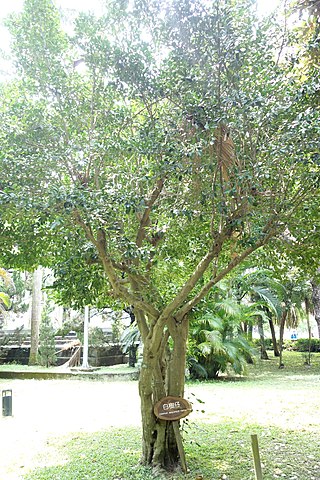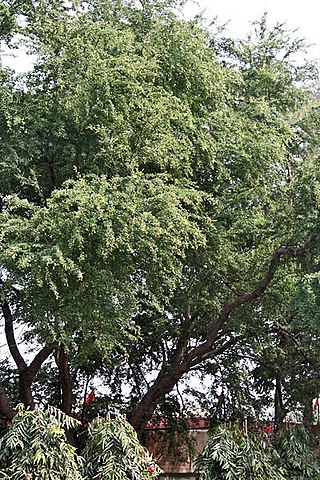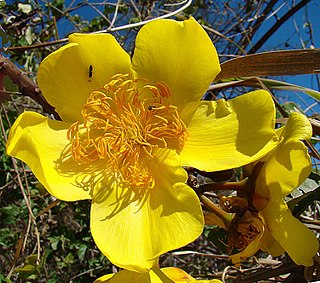
Vigna is a genus of plants in the legume family, Fabaceae, with a pantropical distribution. It includes some well-known cultivated species, including many types of beans. Some are former members of the genus Phaseolus. According to Hortus Third, Vigna differs from Phaseolus in biochemistry and pollen structure, and in details of the style and stipules.

Reseda, also known as the mignonette, is a genus of fragrant herbaceous plants native to Europe, southwest Asia and North Africa, from the Canary Islands and Iberia east to northwest India.

Alternanthera is a genus of flowering plants in the family Amaranthaceae. It is a widespread genus with most species occurring in the tropical Americas, and others in Asia, Africa, and Australia. Plants of the genus may be known generally as joyweeds, or Joseph's coat. Several species are notorious noxious weeds.

Suregada is a plant genus of the family Euphorbiaceae, first described as a genus in 1803. It is native to tropical and subtropical regions of Africa, the Indian Subcontinent, China, Southeast Asia, Australia, and certain oceanic islands.

Pithecellobium dulce, commonly known as Manila tamarind, Madras thorn, monkeypod tree or camachile, is a species of flowering plant in the pea family, Fabaceae, that is native to the Pacific Coast and adjacent highlands of Mexico, Central America, and northern South America. It is also sometimes known as monkeypod, but that name is also used for several other plants, including Samanea saman. It is an introduced species and extensively naturalized in the Caribbean and Florida, as well as the Philippines and Guam via the Manila galleons. It has also been introduced to Cambodia, Thailand and South Asia, It is considered an invasive species in Hawaii.
Pseudalbizzia pistaciifolia is a species of plant in the family Fabaceae. It is found in Colombia, Ecuador, and Venezuela.

Nymphaea nouchali, often known by its synonym Nymphaea stellata, or by common names blue lotus, star lotus, red water lily, dwarf aquarium lily, blue water lily, blue star water lily or manel flower, is a water lily of genus Nymphaea. It is native to southern and eastern parts of Asia, and is the national flower of Bangladesh and Sri Lanka. In Sanskrit it is called utpala. This species is usually considered to include the blue Egyptian lotus N. nouchali var. caerulea. In the past, taxonomic confusion has occurred, with the name Nymphaea nouchali incorrectly applied to Nymphaea pubescens.

Sirhookera is a genus of flowering plants from the orchid family, Orchidaceae. Two species are known, native to India and Sri Lanka.

Persoonia lanceolata, commonly known as lance-leaf geebung, is a shrub native to New South Wales in eastern Australia. It reaches 3 m (10 ft) in height and has smooth grey bark and bright green foliage. Its small yellow flowers grow on racemes and appear in the austral summer and autumn, followed by green fleshy fruits which ripen the following spring. Within the genus Persoonia, P. lanceolata belongs to the lanceolata group of 58 closely related species. It interbreeds with several other species found in its range.

Cassine is a genus of trees, of the plant family Celastraceae.

Launaea sarmentosa is a perennial herb species in the family Asteraceae. It is native to coastal areas in Africa, Madagascar, the Seychelles, Mauritius, India, Sri Lanka, Maldives and Southeast Asia. It is naturalized in Western Australia.

Schleichera is a monotypic genus of plants in the soapberry family, Sapindaceae. There is only one species, Schleichera oleosa, a tree that occurs in the Indian Subcontinent and Southeast Asia.

Tromotriche is a genus of plant in family Apocynaceae. It is native to southern Africa.

Cochlospermum vitifolium or rosa amarilla is a tree belonging to the family Bixaceae. It reaches up to 12 metres (40 ft) in height and its leaves are deciduous. Its flowers are showy, yellow, solitary, and large, up to 10 centimetres (4 in) across. They resemble roses but do not belong to the same family. It inhabits the dry jungles of southern Mexico to Central America from sea level to 1,200 metres (3,900 ft) elevation. Its wood produces a yellow-orange dye used for dyeing cotton clothes.













